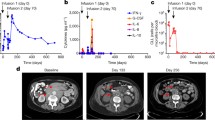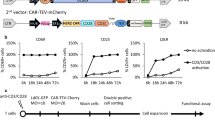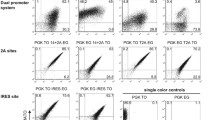Abstract
Adoptive transfer of T lymphocytes is an attractive strategy for many experimental treatment strategies for cancer. Unfortunately, manipulated T cells could be responsible for serious adverse events. Retroviral CD20-transduced T cells may be able to control these unwanted effects. CD20-positive cells are sensitive to rituximab (RTX), a monoclonal antibody specific for CD20. This permits their selective elimination in vivo in case of adverse events. To this end, a system is required that permits efficient and safe transduction of donor T cells and effective elimination of CD20-positive T cells. We constructed different CD20-encoding retroviral vectors and investigated the impact of inclusion of the woodchuck post-transcriptional regulatory element (WPRE) and the chicken hypersensitivity site 4 insulator elements on the levels, homogeneity and stability of CD20 expression. Importantly, inclusion of either WPRE or insulator elements in the retroviral vector resulted in a dramatic improvement in the stability of CD20 expression. The insulator element also led to a much more homogeneous level of CD20 expression. We also show the efficient elimination of the CD20-transgenic T cells via RTX by different effector mechanisms. In conclusion, we have constructed CD20-encoding retroviral vectors with improved efficiency and safety profiles, which can be used as a suicide strategy.







Similar content being viewed by others
References
Bonini C, Ferrari G, Verzeletti S, Servida P, Zappone E, Ruggieri L et al. HSV-TK gene transfer into donor lymphocytes for control of allogeneic graft-versus-leukemia. Science 1997; 276: 1719–1724.
Tiberghien P, Reynolds CW, Keller J, Spence S, Deschaseaux M, Certoux JM et al. Ganciclovir treatment of herpes simplex thymidine kinase-transduced primary T lymphocytes: an approach for specific in vivo donor T-cell depletion after bone marrow transplantation? Blood 1994; 84: 1333–1341.
Introna M, Barbui AM, Bambacioni F, Casati C, Gaipa G, Borleri G et al. Genetic modification of human T cells with CD20: a strategy to purify and lyse transduced cells with anti-CD20 antibodies. Hum Gene Ther 2000; 11: 611–620.
Serafini M, Manganini M, Borleri G, Bonamino M, Imberti L, Biondi A et al. Characterization of CD20-transduced T lymphocytes as an alternative suicide gene therapy approach for the treatment of graft-versus-host disease. Hum Gene Ther 2004; 15: 63–76.
Cartron G, Watier H, Golay J, Solal-Celigny P . From the bench to the bedside: ways to improve rituximab efficacy. Blood 2004; 104: 2635–2642.
Flieger D, Renoth S, Beier I, Sauerbruch T, Schmidt-Wolf I . Mechanism of cytotoxicity induced by chimeric mouse human monoclonal antibody IDEC-C2B8 in CD20-expressing lymphoma cell lines. Cell Immunol 2000; 204: 55–63.
Johnson P, Glennie M . The mechanisms of action of rituximab in the elimination of tumor cells. Semin Oncol 2003; 30: 3–8.
Smith MR . Rituximab (monoclonal anti-CD20 antibody): mechanisms of action and resistance. Oncogene 2003; 22: 7359–7368.
Frank O, Rudolph C, Heberlein C, von NN, Schrock E, Schambach A et al. Tumor cells escape suicide gene therapy by genetic and epigenetic instability. Blood 2004; 104: 3543–3549.
Hacein-Bey-Abina S, von KC, Schmidt M, McCormack MP, Wulffraat N, Leboulch P et al. LMO2-associated clonal T cell proliferation in two patients after gene therapy for SCID-X1. Science 2003; 302: 415–419.
Golay J, Lazzari M, Facchinetti V, Bernasconi S, Borleri G, Barbui T et al. CD20 levels determine the in vitro susceptibility to rituximab and complement of B-cell chronic lymphocytic leukemia: further regulation by CD55 and CD59. Blood 2001; 98: 3383–3389.
Donello JE, Loeb JE, Hope TJ . Woodchuck hepatitis virus contains a tripartite posttranscriptional regulatory element. J Virol 1998; 72: 5085–5092.
Johansen J, Tornoe J, Moller A, Johansen TE . Increased in vitro and in vivo transgene expression levels mediated through cis-acting elements. J Gene Med 2003; 5: 1080–1089.
Zufferey R, Donello JE, Trono D, Hope TJ . Woodchuck hepatitis virus posttranscriptional regulatory element enhances expression of transgenes delivered by retroviral vectors. J Virol 1999; 73: 2886–2892.
Emery DW, Yannaki E, Tubb J, Stamatoyannopoulos G . A chromatin insulator protects retrovirus vectors from chromosomal position effects. Proc Natl Acad Sci USA 2000; 97: 9150–9155.
Emery DW, Yannaki E, Tubb J, Nishino T, Li Q, Stamatoyannopoulos G . Development of virus vectors for gene therapy of beta chain hemoglobinopathies: flanking with a chromatin insulator reduces gamma-globin gene silencing in vivo. Blood 2002; 100: 2012–2019.
Rivella S, Callegari JA, May C, Tan CW, Sadelain M . The cHS4 insulator increases the probability of retroviral expression at random chromosomal integration sites. J Virol 2000; 74: 4679–4687.
Kozak M . The scanning model for translation: an update. J Cell Biol 1989; 108: 229–241.
Ramezani A, Hawley TS, Hawley RG . Performance- and safety-enhanced lentiviral vectors containing the human interferon-beta scaffold attachment region and the chicken beta-globin insulator. Blood 2003; 101: 4717–4724.
Yannaki E, Tubb J, Aker M, Stamatoyannopoulos G, Emery DW . Topological constraints governing the use of the chicken HS4 chromatin insulator in oncoretrovirus vectors. Mol Ther 2002; 5: 589–598.
Kustikova OS, Wahlers A, Kuhlcke K, Stahle B, Zander AR, Baum C et al. Dose finding with retroviral vectors: correlation of retroviral vector copy numbers in single cells with gene transfer efficiency in a cell population. Blood 2003; 102: 3934–3937.
Li Z, Dullmann J, Schiedlmeier B, Schmidt M, von KC, Meyer J et al. Murine leukemia induced by retroviral gene marking. Science 2002; 296: 497.
Cartron G, Dacheux L, Salles G, Solal-Celigny P, Bardos P, Colombat P et al. Therapeutic activity of humanized anti-CD20 monoclonal antibody and polymorphism in IgG Fc receptor FcgammaRIIIa gene. Blood 2002; 99: 754–758.
Clynes RA, Towers TL, Presta LG, Ravetch JV . Inhibitory Fc receptors modulate in vivo cytoxicity against tumor targets. Nat Med 2000; 6: 443–446.
Pfeiffer M, Stanojevic S, Feuchtinger T, Greil J, Handgretinger R, Barbin K et al. Rituximab mediates in vitro antileukemic activity in pediatric patients after allogeneic transplantation. Bone Marrow Transplant 2005; 36: 91–97.
Kingsman SM, Mitrophanous K, Olsen JC . Potential oncogene activity of the woodchuck hepatitis post-transcriptional regulatory element (WPRE). Gene Therapy 2005; 12: 3–4.
Sirma H, Giannini C, Poussin K, Paterlini P, Kremsdorf D, Brechot C . Hepatitis B virus X mutants, present in hepatocellular carcinoma tissue abrogate both the antiproliferative and transactivation effects of HBx. Oncogene 1999; 18: 4848–4859.
Poussin K, Dienes H, Sirma H, Urban S, Beaugrand M, Franco D et al. Expression of mutated hepatitis B virus X genes in human hepatocellular carcinomas. Int J Cancer 1999; 80: 497–505.
Engels B, Cam H, Schuler T, Indraccolo S, Gladow M, Baum C et al. Retroviral vectors for high-level transgene expression in T lymphocytes. Hum Gene Ther 2003; 14: 1155–1168.
Serafini M, Bonamino M, Golay J, Introna M . Elongation factor 1 (EF1alpha) promoter in a lentiviral backbone improves expression of the CD20 suicide gene in primary T lymphocytes allowing efficient rituximab-mediated lysis. Haematologica 2004; 89: 86–95.
Kohn DB, Sadelain M, Glorioso JC . Occurrence of leukaemia following gene therapy of X-linked SCID. Nat Rev Cancer 2003; 3: 477–488.
Baum C, von KC, Staal FJ, Li Z, Fehse B, Schmidt M et al. Chance or necessity? Insertional mutagenesis in gene therapy and its consequences. Mol Ther 2004; 9: 5–13.
Kohn DB, Sadelain M, Dunbar C, Bodine D, Kiem HP, Candotti F et al. American Society of Gene Therapy (ASGT) ad hoc subcommittee on retroviral-mediated gene transfer to hematopoietic stem cells. Mol Ther 2003; 8: 180–187.
Walters MC, Fiering S, Bouhassira EE, Scalzo D, Goeke S, Magis W et al. The chicken beta-globin 5′HS4 boundary element blocks enhancer-mediated suppression of silencing. Mol Cell Biol 1999; 19: 3714–3726.
Schambach A, Wodrich H, Hildinger M, Bohne J, Krausslich HG, Baum C . Context dependence of different modules for posttranscriptional enhancement of gene expression from retroviral vectors. Mol Ther 2000; 2: 435–445.
Auten J, Agarwal M, Chen J, Sutton R, Plavec I . Effect of scaffold attachment region on transgene expression in retrovirus vector-transduced primary T cells and macrophages. Hum Gene Ther 1999; 10: 1389–1399.
Kessels HW, van dB, Spits H, Hooijberg E, Schumacher TN . Changing T cell specificity by retroviral T cell receptor display. Proc Natl Acad Sci USA 2000; 97: 14578–14583.
Weijtens M, van SA, Hagenbeek A, Braakman E, Martens A . Reduced graft-versus-host disease-inducing capacity of T cells after activation, culturing, and magnetic cell sorting selection in an allogeneic bone marrow transplantation model in rats. Hum Gene Ther 2002; 13: 187–198.
Jedema I, van der Werff NM, Barge RM, Willemze R, Falkenburg JH . New CFSE-based assay to determine susceptibility to lysis by cytotoxic T cells of leukemic precursor cells within a heterogeneous target cell population. Blood 2004; 103: 2677–2682.
Acknowledgements
We are grateful to Dr Ton NM Schumacher (Netherlands Cancer Institute, Amsterdam, The Netherlands) for providing the pMX retroviral vector; Dr Gary Nolan (Stanford University, Stanford, CA) for the amphotrophic packaging cell line Phoenix; Dr Christopher Baum for the WPRE element and Dr Gary Felsenfeld for insulator elements. The work was supported by EC Grant QLK3 CT 2001-01265.
Author information
Authors and Affiliations
Corresponding author
Rights and permissions
About this article
Cite this article
van Meerten, T., Claessen, MJ., Hagenbeek, A. et al. The CD20/αCD20 ‘suicide’ system: novel vectors with improved safety and expression profiles and efficient elimination of CD20-transgenic T cells. Gene Ther 13, 789–797 (2006). https://doi.org/10.1038/sj.gt.3302705
Received:
Revised:
Accepted:
Published:
Issue Date:
DOI: https://doi.org/10.1038/sj.gt.3302705
- Springer Nature Limited
Keywords
This article is cited by
-
Antitumor effects of an engineered and energized fusion protein consisting of an anti-CD20 scFv fragment and lidamycin
Science China Life Sciences (2011)
-
An Improved Bicistronic CD20/tCD34 Vector for Efficient Purification and In Vivo Depletion of Gene-Modified T Cells for Adoptive Immunotherapy
Molecular Therapy (2010)
-
Adoptive T-cell Immunotherapy of Cancer Using Chimeric Antigen Receptor-Grafted T Cells
Archivum Immunologiae et Therapiae Experimentalis (2010)
-
TCR transgenes and transgene cassettes for TCR gene therapy: status in 2008
Cancer Immunology, Immunotherapy (2009)
-
Sleeping Beauty Transposon‐mediated Engineering of Human Primary T Cells for Therapy of CD19+ Lymphoid Malignancies
Molecular Therapy (2008)




